With Home Runs being hit
at a record pace in 2017, the
"Juiced" baseball is back in
the news. Since the dead ball
era, there have always been
accusations that Spalding
periodically introduced lively
or "juiced" balls, made by
winding the yarn inside the
ball tighter. Through the years
whenever the offense was
dominated by good pitching
Major league baseball either
made rule changes to give the
batter an edge over the pitcher
or try to introduce a baseball
that was more lively or easier
to see.

The Yellow baseball was
an experiment brained stormed
by Brooklyn Dodgers president
Larry MacPhail in 1938. The
inventor Fredric H. Rahr, felt
the high viability of the
Baseballs were easier to hit,
field, and lesson the danger of
players being hit by pitched
balls. Advocate's for the ball
also pointed out that the ball
would be seen better at night,
and would be a great help to
hitters when the pitcher was
working against a white
background of "Shirt-Sleeved
bleacher boys."
Used in an official Major League game, the yellow baseballs were given a
trial on August 2, 1938. The
first game of a Brooklyn
Dodgers double header against
the St. Louis cardinals at
Ebbets Field. The two teams
went back to the white ball in
the second game as the Dodgers
swept the doubleheader 6–2 and
9–3. The trial resulted in a
hung jury, and mixed reviews.
It seemed that the players that
did well approved of it, and
the players that had a bad game
did not.
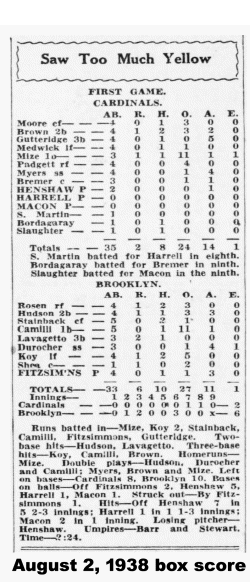
Babe Ruth a coach for the Brooklyn Dodgers at the time said "I didn't even
know it was yellow until
somebody fouled one down there
by me. The color don't make no
difference. Its the guy who's
chucking 'em at you that
counts. When a good pitcher is
throwing that ball they all
look like aspirin tablets."
Dodgers shortstop Leo Durocher
said he didn't care what ball
the league used. "When you hit
the way I do," Leo Laughed,
"they can throw a red ball, a
green ball, or a fancy dress
ball, even, and it doesn't make
any difference. I can miss any
and all kinds."
Dodgers starter and winning pitcher Freddie Fitzsimmons, said something
has to be done about the yellow
dye before the ball would be
any good. "That dye started
coming off all over my hands
before the first inning was
over, and soon after the ball
got so slick I could Hardly get
a hold of it."Inventor F.H. Rahr who attended the game said
We've had chemists working for
months trying to find a dye
that would withstand
perspiration and still not be
oily."
The following year the problem
with the dye running was
solved. The ball was used for
the second time on July 23,
1939 in the first game of a
double header against the St.
Louis Cardinals who won the
game 12-0. The St. Louis
players were overwhelmingly in
favor of the yellow ball, and
the Brooklyn Dodgers more or
less opposed it. The Yellow
Ball was used for the last time
on July 30, in the first game
of a Cardinals, Dodgers double
header in St. Louis. Although
the fans, and press were in
favor of the ball, it did not
win out with the players or the
league.
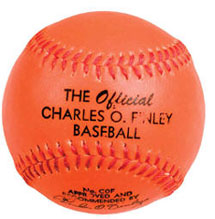
In 1963 Kansas City Athletics owner Charles O. Finley came up with the
idea in coloring the baseballs
orange. According to Finley's
suggestion the 'Alert Orange'
used to identify military
planes would make the flight of
the baseball easier to follow.
The idea was quickly shot down
by Warren Giles, President of
the National League and quoted
"Whether or not formal league
action is taken, I would not
permit use of the orange ball.
Only baseballs bearing my
signature as league president
may be used in National League
games and I would not allow my
signature to be applied to any
baseball color other than
white."
The maverick owner of the newly located Oakland Athletics, Charles O.
Finley, was at it again in
1973. Making its debut in a
major League game, on March 29,
the orange ball was used in a
spring training exhibition loss
to the Indians 11-6. Although
the ball was used one more
time, 4 days later against the
California Angels, Bowie Kuhn
balked at letting him try it in
a regular-season ball game.
Both Major League pitchers, and
hitters had complaints about
the orange ball. The hurlers
said the ball was too slick,
while the batters, despite the
offensive barrage, said they
were unable to pick up the spin
on the ball.
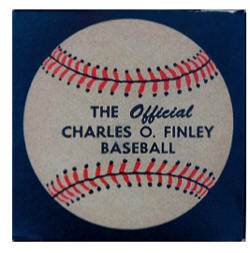
In lower level exhibition games, fans reacted in an overwhelmingly
positive manner to the Orange
Baseball. Umpires also attested
to the benefits of the Orange
Baseball, stating that the ball
was not only easier to see from
behind the plate, but gave rise
to a greater number of hits and
fewer fielding errors in
exhibition games in which the
orange baseball was used. The
ball never caught on at the big
league level.
The Spalding 5x baseball, so called because it was 5% livelier, was an
experimental baseball used in
selected spring training games
in 1970. Baseball Commissioner
Bowie Kuhn allowed Major League
Clubs to experiment with the
Juiced-up 5X baseball, to be
used in every exhibition game
played on Wednesdays during the
spring training exhibition
schedule. The first round of
Wednesday games played on March
18, 1970, saw four teams
scoring in double figures, and
lost. There were 208 runs
scored for an average of 17.3
per game, which was more than
twice the average scoring of
8.1 runs in games played in
1969.

The Seattle Pilots combined with the Cleveland Indians for 34 hits and 7
home runs. The pilots who moved
to Milwaukee after spring
training and renamed the
Brewers won the game 19-13. The
Washington Senators produced 8
runs in the 6th inning against
Kansas City then 5 more in the
11th to win a close one 18-13.
The Cubs beat the Athletics
12-11. Detroit collected 19
runs and 21 hits in beating the
White Sox 19-13. Chicago's
manager Don Gutteridge told Joe
Cronin, President of the
American League that four
pitchers were hit by line
drives.

Cronin said that he saw enough, and that the 5X baseball should be
outlawed. The experiment was
discontinued because of
concerns over the safety of
both players and fans. Bowie
Kuhn who was in favor of all
the run scoring canceled the
remaining Wednesday Juiced-Ball
games. The Major League
pitchers were thankful, but
felt the baseballs used in the
1970 season were livelier than
the year before, as evident by
the improved success hitters
were having. A.G. Spalding
denied that the regulation
balls were livelier.
Bob Gibson of the St. Louis Cardinals thought that the batters were just
hitting better. He went on to
explain "The new strike zone is
beginning to take effect.
Everything they have been doing
to the rules has hurt the
pitcher, and then they wonder
why the earned run averages
aren't lower.
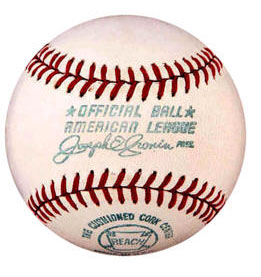
Reports
of Juiced American League
baseballs surfaced in 1973.
Baseball commissioner Bowie
Kuhn was asked to investigate
the inconsistency of baseballs
being made at the time. One
with green printing and the
other with blue. Numerous
pitchers have remarked about
the larger size of the
blue-labeled balls and Dick
Walsh, general manager of the
Angels, had asked Kuhn to
investigate. The blue-labeled
balls were larger by about
one-quarter inch in diameter,
had wider stitching, looser
covers and don’t go as far when
hit.
The green-labeled balls were said to go farther when hit, especially in
cool weather. The balls were
made in Mayaguez, Puerto Rico.
The green ball had glue all
over it right under the cover,
which was responsible for its
greater resiliency. Poor
quality control was blamed and
the problem was corrected.
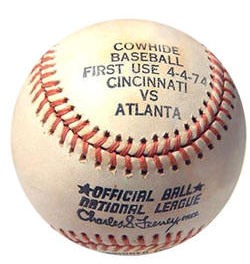
In 1974 after more than 100 years of using horsehide covers Major League
Baseball approved the use of
cowhide. Horsehide became hard
to come by, and cowhide was
more accessible. On April 4,
1974 the the first cowhide
baseballs were introduced into
the game using specially marked
commemorative baseballs. In the
national League game Hank Aaron
hit Home run 714, putting him
in a tie with Babe Ruth for
career Home Runs.
Both the Cowhide and Horsehide baseballs were used in the game. Arrons
Record tying home run came with
the Horsehide ball. Home run
hitters across the league
complained about the switch
from horsehide as Hank Aaron
stated months later "If you hit
the cowhide baseball once or
twice, they go soft. There's
just no question about it, I
know the ball is softer." In
1974 Home Runs decrease by 15
percent. By the end of the 1975
season the Horsehide baseballs
were completely gone. Finally a
baseball made in favor of the
pitcher. The Cowhide baseball
had less Horsepower.


